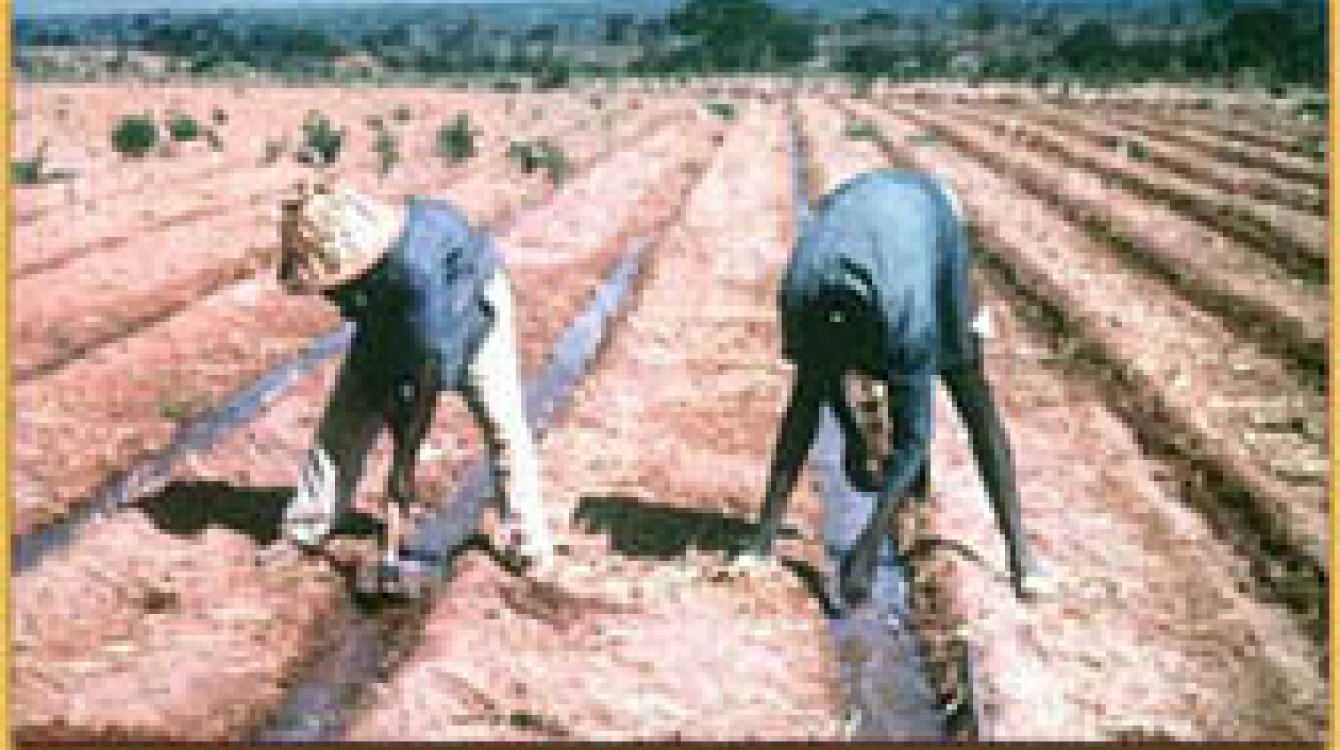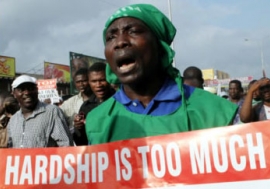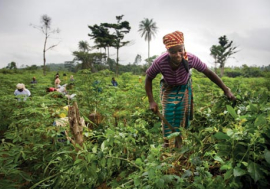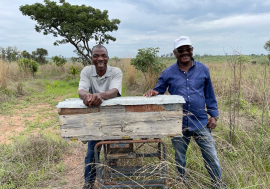Agriculture: Africa's 'engine for growth'
After decades of economic stagnation and with the number of chronically malnourished people now reaching 200 million, Africa's leaders are intensifying efforts to find “sustainable solutions” to hunger and poverty, says Nigerian President Olusegun Obasanjo. The main framework for that undertaking, he notes, is the New Partnership for Africa's Development (NEPAD), which emphasizes that “agriculture will provide the engine for growth in Africa .”
To give greater substance to that goal, NEPAD's promoters held a series of consultations with African agriculture ministers and the heads of African regional economic groups, the African Development Bank and the UN Economic Commission for Africa , as well as experts from the World Bank and especially the UN Food and Agriculture Organization (FAO). Together, they developed the Comprehensive Africa Agriculture Development Programme (CAADP), released in July 2003.

Photo: © UNDP / M.L. Hanley
The plan states that the high economic growth rates envisaged by NEPAD cannot be realized unless farm production is significantly increased. Higher output will directly reduce hunger and bring down the cost of food imports. It will also have wider economic benefits, from stimulating rural incomes to providing raw materials for African industry. “Investing in the reduction of hunger is a moral imperative,” says the CAADP, “but it also makes economic sense.”
Since the hindrances facing African farmers are numerous, the solutions must be comprehensive, requiring sustained action across many different fronts. Above all, says the plan, African governments and their external partners must support the labours of Africa's millions of poor, small-scale farmers.
Building on local successes
The rural locality of Tonka, in northern Mali, is an example of the endeavours that villagers in Africa are already making, despite extremely adverse conditions. By digging simple irrigation canals from a local river and lake, Tonka's 4,500 producers, organized in village cooperatives, have been able to increase their output of rice, millet, sorghum, potatoes, cassava, beans and other foods. Tonka's marketplaces now attract buyers from other regions in Mali, and even from across the border in neighbouring Mauritania. Thanks to the additional incomes they have earned, Tonka's residents have been able, during the past four years, to help finance the construction of nine primary schools, four health clinics, several wells, two livestock markets, a warehouse and several sanitation facilities.
Where such success stories exist, acknowledges the CAADP, the challenge facing African leaders will be to find ways to strengthen them and duplicate their experiences in other localities and countries. Where there are few successes to build on, new initiatives and programmes will need to be promoted.
The plan's drafters affirm that it is not a blueprint, and that its vision must be adapted to the specific problems of particular regions and countries. Nor is it a shopping list of projects. “Its main purpose is to sensitize policymakers to the need to act on selected fronts in order to make a quick difference to Africa's agricultural malaise.” It therefore concentrates on what it calls the three “pillars” for short-term action, plus a fourth long-term pillar. These are:
• extending the land area under sustainable land management and reliable water control systems
• increasing food supply and reducing hunger
• improving rural infrastructure and capacities for market access
• promoting, over the long term, agricultural research and technology dissemination.
A continent in crisis
African agriculture is in crisis, the CAADP affirms, and that situation “demands a crisis response.” Although urbanization is increasing rapidly, agriculture still provides livelihoods for about 60 per cent of the continent's active labour force, contributes 17 per cent of Africa's total gross domestic product and accounts for 40 per cent of its foreign currency earnings.
Yet farmers' yields have essentially stagnated for decades. Although total output has been rising steadily — often by simply extending the land area under cultivation — this growth has barely kept pace with Africa's increasing population. Food production in particular has lagged, so that the number of chronically undernourished people increased from 173 million in 1990-92 to 200 million in 1997-99, the latest years for which accurate figures are available. Of that total, 194 million were in sub-Saharan Africa . This growth in hunger has come despite high levels of food imports — costing $18.7 bn in 2000 alone.
The reasons for such stagnation are multiple, says the CAADP: continuing dependence on uncertain rainfall, nutritional deficiencies in Africa's soils, small and dispersed domestic markets, the instability and decline of world prices for African agricultural exports, the small size of most farms, farmers' frequent lack of organization, the lack of rural roads, neglect of the particular needs of women farmers (who produce most of the continent's food), and the spread of HIV/AIDS.
Government agricultural policies also have been poor, providing only weak economic incentives to rural producers. Privatization and other structural adjustment policies led to an “over-hasty withdrawal” of the state from direct production. In the absence of a sound private sector, this caused “severe dislocation of production, farm trade and farmer support services.”
Agriculture also has been starved of investment. Many African governments devote less than 1 per cent of their budgets to agriculture. Not only have overall donor aid levels declined, but donor priorities have simultaneously shifted away from agriculture toward other sectors. Worldwide, the amount of aid allocated to primary agriculture declined from $11 bn in 1990 to $7.4 bn in 1998. The decline has been especially sharp in the case of the World Bank, which provided 39 per cent of its total lending to agriculture in 1987, but only 7 per cent in 2000.
Although available financial resources should be managed better, the CAADP acknowledges, overall investments in agriculture need to be drastically increased if Africa is to pull out of its agricultural crisis. The four pillars highlighted in the plan will require $251 bn in investments between 2002 and 2015 (see table). Although an ambitious amount, the annual average of $17.9 bn is less than the continent spends each year on food imports. The plan expects that Africa will be able to mobilize about half of the total amount from its own resources, with its share gradually increasing as the continent strengthens its domestic capacities.
Required investments in African agriculture, 2002-2015
Activity
US$ bn
Land and water investment
37
operations and maintenance
32
Rural infrastructure investment
89
operations and maintenance
37
Trade-related capacities
3
National food security
6
Regional food security
1
Research and technology
5
Humanitarian safety nets
42
Total
251
Source: Comprehensive Africa Agriculture Development Programme
Boosting yields
Much can be done to increase African farm yields through simple methods of improving soil fertility and better utilizing the continent's available water. Currently, only 12.6 mn hectares of agricultural land are under managed systems of water and land development. The vast bulk of farmland is left to the vagaries of weather, including insufficient rainfall and flooding that may strip away topsoils, as well as unsustainable farming methods that gradually deplete soil nutrients.
Some 874 mn hectares of land are deemed suitable for agriculture, but 83 per cent of that area is subject to serious limitations such as poor soil fertility. About 16 per cent of Africa's soils are categorized as “low nutrient,” compared with just 4 per cent in Asia . Each year, the depletion of existing soil nutrients brings crop losses estimated at between $1 bn and $3 bn.
These nutrients are not being replaced. Total fertilizer input in sub-Saharan Africa is just 9 kilogrammes per hectare, compared with 100 kg in South Asia , 135 in East and Southeast Asia , 73 in Latin America and 206 in the industrialized countries. The CAADP calls for an integrated approach that combines much greater use of organic matter and mineral fertilizers, higher-yielding hybrid seeds, small-scale irrigation and other methods.
The plan notes that just 7 per cent of arable land in Africa is under irrigation (with 40 per cent of that land area in North Africa). As with fertilizer use, Africa's utilization of irrigation pales in comparison with other regions: the share of irrigated farmland in South America stands at 10 per cent, in East and Southeast Asia at 29 per cent and in South Asia at 41 per cent.
(see graph)
While the CAADP points to the need to upgrade and rehabilitate existing large-scale irrigation schemes, and to develop new ones, it emphasizes in particular the importance of promoting small-scale efforts within the reach of poor farmers. Through a combination of approaches, it hopes to increase the area of irrigated farmland from 12.6 mn hectares to 20 mn by 2015.
While raising agricultural productivity across-the-board is essential for reducing rural poverty and stimulating economic growth, focusing on food supply — another of the plan's pillars — is indispensable for combating hunger. One-third of sub-Saharan Africa's population is chronically hungry. On average, cereal yields in Africa reached just 1,230 kg per hectare in 2001, compared with 3,090 kg in Asia, 3,040 kg in Latin America and 5,470 kg in the European Union.
In addition to boosting the yields of staple food crops, better “safety nets” also need to be put in place to protect poor people during times of calamity, such as drought, flooding or the ravages of war, argues the CAADP.
Roads and marketplaces
In Sikorola, a village in western Burkina Faso, farmers generally benefit from adequate rains and more fertile soils. But their efforts to expand output are hampered by the area's very poor physical infrastructure. “We are ready to produce more maize and potatoes,” says one member of the Siguizani family, “but there is no road to transport the crop.”
Sikorola is not unusual. Across Africa, paved rural roads scarcely exist. Much produce is taken to market by cart or bicycle over unpaved roads or by foot along narrow paths cut through the brush. Africa has the lowest density of paved roads of any world region. Out of 1.8 mn kilometres of roads in sub-Saharan Africa , only 16 per cent are paved.
Moreover, many of Africa's paved roads have deteriorated badly from overuse and inadequate maintenance. Because of poor road quality, lorry drivers in rural Cameroon may charge an extra CFA1,000-CFA2,000 (US$1.70-$3.40) for just a short trip of 6 kilometres. Higher transport costs raise the prices farmers must charge, reducing their competitiveness in both domestic and international markets.
Because farmers will not have much incentive to grow more without the roads, storage facilities and other physical infrastructure they need to market their crops, the CAADP urges that more than half of the investments projected under the plan be directed toward rural infrastructure (not counting irrigation systems). In addition to roads and other “hard” infrastructure, the CAADP argues, farmers also need “soft” infrastructure: communications and accurate price and market information in order to take the best advantage of changing market opportunities.
External markets also are vital for many of Africa's producers of cotton, cocoa, coffee, tea and other export crops. Yet world market conditions have not been favourable to African farmers. Not only are international agricultural prices volatile, but African exports face restrictions on access to Northern markets and are severely hurt by the high subsidies paid to rich farmers in the industrialized countries.
“It is an irony,” notes the NEPAD agricultural plan, “that many African countries have largely internalized the perspective that a dynamic and sustainable agricultural economy cannot be based on subsidies; yet their agricultural systems continue to be undermined by the subsidies paid out in precisely the developed countries that are the main proponents of liberalization.”

To make it worthwhile for farmers to produce more, they need enough decent roads to get their crops to market.
Photo: © UNDP / Ruth Massey
Technology for development
To succeed, Africa's efforts to boost agricultural output must also rely on greater use of science and technology, the plan's fourth, long-term pillar. Currently, only about 20 per cent of cropland in Africa is sown with improved cereal varieties. Many new varieties of maize and rice have been developed in laboratories, but must be better adapted to Africa's environmental conditions, as in the case of the New Rice for Africa (see page 10). Research has shown that improved varieties of millet, sorghum and other traditional African grains can also significantly boost yields. Beyond seeds, farmers need access to animal health remedies, safe pesticides and other inputs, as well as training in agro-forestry and various skills.
Africa's agricultural research institutes and extension services have very little capacity to engage in new scientific research or get existing technologies out into farmers' fields. In part, such problems can be overcome by finding new ways to generate and handle scientific knowledge, says the CAADP. Farmers themselves should be more closely involved in both research and dissemination.
Mr. Pedro Sanchez, director for tropical agriculture at Columbia University's Earth Institute, agrees. The days of fenced-off research plots are gone, he told Africa Recovery. Instead, researchers must “start with participation,” by listening to what farmers themselves have to say. Existing agricultural extension services must also change the way they operate, said the soil fertility specialist, who was the winner of the World Food Prize in 2002 and is currently a co-chair of the Millennium Project Hunger Task Force, a UN advisory group. “We need to blur the differences between research and extension,” Mr. Sanchez said.
While changes in functioning are important, says the CAADP, so too is greater financing. Public spending on agricultural research rose rapidly between 1961 and 1976, but stagnated during the 1980s and 1990s, at around $1.2 bn annually. African agricultural research institutes meanwhile became more dependent on donor financing, which rose from 28 per cent of the total in 1986 to about 40 per cent today.
Overall spending on agricultural research should double within 10 years, says the NEPAD agricultural plan. To achieve that, research and extension services will need to diversify their sources of financing, increasing not only allocations from national budgets and donor agencies, but also by tapping the private sector, selling consultancy services to producers' organizations, deriving income from patents and urging governments to place levies on commodity sales.
With adequate resources, says the plan, it will be much easier to build “a pluralistic and integrated system of agricultural research, extension and education that are responsive and accountable to farmers, agribusiness, consumers and other stakeholders.”


















